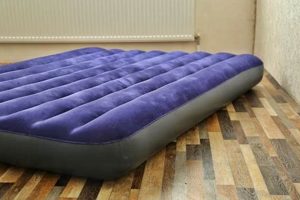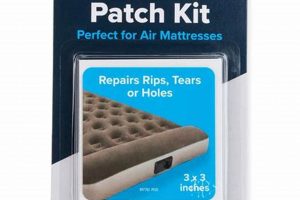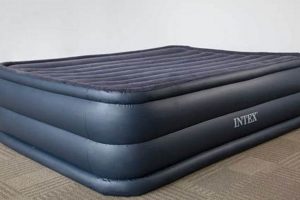An inflatable sleeping surface engineered to withstand penetration from sharp objects constitutes a durable and convenient option for temporary bedding. These beds incorporate materials and construction techniques designed to minimize the risk of deflation caused by punctures, enhancing their reliability in diverse environments. As an example, a camping trip in a rocky area necessitates a robust sleeping solution, and this type of bed offers a practical alternative to traditional sleeping pads.
The advantage of utilizing such a product lies in its enhanced longevity and suitability for demanding conditions. The risk of sudden deflation is reduced, contributing to uninterrupted sleep and increased comfort. Historically, air mattresses were perceived as fragile and prone to leaks; however, advancements in materials science have led to significant improvements in puncture resistance, making them a more viable option for both indoor and outdoor use.
The following sections will explore the specific materials used in the construction of these resilient beds, the technologies employed to enhance their durability, and the various factors to consider when selecting the most appropriate model for individual needs. Understanding these aspects ensures an informed purchasing decision.
Guidance on Selection and Maintenance
Optimizing the lifespan and performance requires careful selection and diligent maintenance practices. Adhering to the following guidelines ensures prolonged usability and minimizes the risk of unexpected failures.
Tip 1: Material Evaluation: Examine the composition of the air mattress. Reinforced PVC or multiple layers of laminated materials typically offer superior resistance compared to single-layer, thinner alternatives. Consider denier ratings for nylon or polyester fabrics, higher denier indicates greater tear resistance.
Tip 2: Seam Inspection: Carefully scrutinize the seams. Welded or reinforced seams are less susceptible to failure than stitched seams. Look for evidence of meticulous construction and consistent sealing along all edges.
Tip 3: Inflation Control: Avoid overinflation. Exceeding the recommended pressure can stress the material and seams, increasing the likelihood of rupture. Use a pump with a pressure gauge to ensure accurate inflation.
Tip 4: Protective Layer: Utilize a protective barrier. Placing a blanket or tarp beneath the air mattress shields it from abrasive surfaces, reducing the risk of punctures from rocks, twigs, or other sharp objects.
Tip 5: Storage Protocol: Store in a clean, dry environment. Thoroughly clean and deflate the air mattress before storing it in a temperature-controlled space. Avoid direct sunlight and extreme temperatures, which can degrade the material.
Tip 6: Regular Inspection: Conduct periodic checks for wear and tear. Examine the surface for signs of abrasion, discoloration, or small punctures. Address any issues promptly to prevent further damage.
Following these recommendations significantly extends the operational life and preserves the integrity, offering a reliable and comfortable sleeping solution for various applications. Prioritizing material quality, construction details, and proper maintenance procedures is essential for maximizing the investment.
The ensuing discussion will focus on repair strategies for minor punctures and the availability of specialized repair kits designed to restore functionality to compromised units.
1. Material Composition
The inherent resistance to puncture exhibited by an air mattress is fundamentally determined by its constituent materials. The choice of material directly influences the ability of the mattress to withstand penetration from sharp objects, abrasion from rough surfaces, and degradation from environmental factors. High-quality materials, such as reinforced polyvinyl chloride (PVC) or thermoplastic polyurethane (TPU) with high denier ratings, possess greater tensile strength and elasticity, enabling them to deform under stress without succumbing to tearing or puncture. The selection of appropriate materials is, therefore, the primary determinant of an air mattress’s ability to maintain inflation and provide reliable support over an extended period.
Consider, for example, an air mattress constructed from a thin, single layer of low-grade PVC. Such a mattress is highly susceptible to punctures from even small objects, such as pebbles or twigs, rendering it unsuitable for outdoor use or prolonged use in environments where sharp objects are present. Conversely, an air mattress utilizing multiple layers of laminated, reinforced PVC, potentially incorporating a nylon or polyester scrim, demonstrates significantly enhanced resistance. The layered construction distributes stress more evenly, and the scrim acts as a barrier, preventing small punctures from propagating into larger tears. A real-world illustration involves the difference between basic, inexpensive air mattresses commonly found in discount stores and the more robust, heavy-duty models designed for camping or emergency preparedness; the difference in material quality is immediately apparent and directly correlates with the mattresses’ respective lifespans and reliability.
In summary, material composition is not merely a superficial attribute but rather the foundational element dictating the performance and longevity of an air mattress. Understanding the specific properties of different materials, their resistance to puncture, and their susceptibility to environmental degradation is crucial for making informed purchasing decisions. While seemingly similar in appearance, air mattresses can vary dramatically in their ability to withstand the rigors of use, and the material composition is the most significant factor driving this disparity. Consequently, careful attention to material specifications is paramount when seeking a dependable and durable inflatable sleeping surface.
2. Seam Integrity
Seam integrity is a critical, albeit often overlooked, component in the overall performance and longevity of a air mattress. While the material itself may exhibit significant resistance, compromised seams can negate these advantages, leading to air leakage and eventual failure. Seam construction and materials directly influence the ability of a mattress to maintain pressure and withstand repeated use.
- Seam Construction Techniques
The method of seam construction is paramount. Welded seams, achieved through radio frequency (RF) welding or heat sealing, create a fusion between material layers, resulting in a stronger and more airtight bond than traditional stitched seams. Stitched seams, while potentially more cost-effective, are inherently vulnerable due to the presence of needle perforations, which can propagate into larger tears over time. The choice of welding versus stitching direct
ly impacts the mattress’s ability to withstand stress and maintain inflation under load. For instance, a mattress with welded seams is far more likely to survive repeated inflation and deflation cycles without developing leaks. - Seam Reinforcement
Reinforcement techniques further enhance seam integrity. Applying reinforcing tape or incorporating additional material layers along the seam lines distributes stress and prevents localized failures. This is particularly important in areas subject to high stress, such as corners and edges. Some manufacturers utilize specialized seam designs that interlock the material layers, providing an even stronger bond and minimizing the risk of separation. An example is the use of a double-sealed seam with reinforcing tape, which is significantly more robust than a single-stitched seam without reinforcement.
- Material Compatibility
The compatibility of the seam materials with the mattress material is crucial. The adhesive or welding process must create a strong and lasting bond without compromising the integrity of either material. Incompatible materials can lead to delamination or premature failure of the seam. For example, using an inappropriate adhesive on PVC can result in the adhesive degrading over time, causing the seam to weaken and eventually fail. Selecting compatible materials and appropriate bonding techniques is essential for ensuring long-term seam integrity.
- Quality Control Processes
Stringent quality control measures during manufacturing are indispensable for ensuring seam integrity. These measures include visual inspections for defects, pressure testing to identify leaks, and destructive testing to assess seam strength. Rigorous testing throughout the manufacturing process helps to identify and correct potential weaknesses before the mattress reaches the consumer. For example, manufacturers often use air inflation testing in a controlled environment to identify any potential seam weak points and address them proactively.
Therefore, seam integrity is intrinsically linked to the overall value and performance. A mattress may boast high material resistance, but inadequate seam construction will compromise its reliability and reduce its lifespan. Prioritizing seam construction techniques, reinforcement methods, material compatibility, and quality control processes contributes significantly to the durability and longevity of any air mattress, particularly those designed for rugged use.
3. Inflation management
Inflation management exerts a direct influence on the lifespan and performance of a air mattress. Proper inflation techniques contribute significantly to preventing punctures and maintaining structural integrity. Overinflation increases internal pressure, predisposing the material to stress fractures and making it more vulnerable to penetration from sharp objects. Conversely, underinflation compromises support and can lead to excessive flexing, which fatigues the material and weakens seams. Maintaining the recommended pressure, typically indicated on the mattress, is thus critical. For instance, exceeding the pressure threshold can cause seam separation, especially under weight, even if the material itself is highly resistant.
Pressure regulation is vital to preventing common failures. Temperature fluctuations affect internal air volume; during periods of warming, the air inside expands, increasing pressure, while cooling causes contraction and potential deflation. Regular monitoring and adjustment compensate for these environmental changes. Integrated pumps with pressure sensors or external pressure gauges facilitate accurate inflation and prevent inadvertent overfilling. Consider a scenario where an air mattress is inflated indoors at room temperature and then moved to a cooler outdoor environment; the subsequent pressure drop requires a top-up to maintain optimal support. Furthermore, avoiding the use of high-pressure air compressors, which can rapidly inflate the mattress beyond its capacity, is essential to mitigating risk.
In conclusion, effective inflation management is integral to maximizing both the comfort and durability. Ignoring pressure guidelines and environmental factors precipitates premature wear and elevates the risk of punctures. Consistent adherence to recommended inflation practices, coupled with diligent monitoring and adjustment, preserves material integrity and extends functional life. Accurate pressure control is not merely a convenience; it is a fundamental component in preserving its intended robustness.
4. Protective barriers
Protective barriers serve as a critical supplementary defense mechanism, significantly augmenting the inherent resilience of a puncture resistant air mattress. While the mattress itself is engineered with robust materials and construction to minimize vulnerability, external protective layers act as the first line of defense against potential punctures and abrasions. The implementation of barriers is rooted in the principle of mitigating direct contact between the sleeping surface and potentially damaging elements present in the surrounding environment. Failure to utilize such measures increases the probability of compromised integrity, despite the mattress’s inherent resistance. An illustrative example is placing the mattress directly on a rocky surface; even with enhanced puncture resistance, prolonged exposure to sharp edges increases the likelihood of eventual failure. Thus, protective barriers transform a resistant product into a more durable and lasting solution.
The selection of appropriate barriers necessitates careful consideration of the intended use environment. Indoor applications may benefit from simple fabric layers such as thick blankets or rugs, preventing abrasion from flooring or accidental punctures from dropped objects. Outdoor use, however, demands more robust solutions like ground tarps constructed from durable, waterproof materials. The practical application of a ground tarp beneath the mattress during camping effectively shields it from rocks, roots, and other sharp debris commonly encountered in natural settings. Furthermore, using mattress protectors adds an additional layer of defense against spills, stains, and even microscopic abrasions, contributing to long-term hygiene and material preservation. Consider also, the benefit of these barriers, by extending life span of the mattress, reduces waste and promotes more sustainable consumption.
In summation, the strategic integration of protective barriers is not merely an optional add-on but an essential component in maximizing the performance and longevity. While a puncture resistant air mattress provides a degree of inherent protection, the implementation of external barriers significantly reduces the risk of damage and extends the service life. This combined approach yields a more reliable and durable sleeping solution, capable of withstanding the rigors of diverse environments. The understanding of this synergistic relationship is paramount in making informed decisions regarding use, maintenance, and overall value optimization.
5. Storage conditions
The longevity and performance capabilities of a puncture resistant
air mattress are intrinsically linked to the conditions under which it is stored when not in use. Improper storage precipitates material degradation, compromising its ability to withstand punctures and maintain inflation. The causal relationship between storage practices and mattress lifespan is direct: adverse storage environments accelerate wear and tear, diminishing the inherent benefits of puncture-resistant construction. Considering storage conditions as an integral component of air mattress maintenance is essential for realizing the full potential of its design.
The effects of improper storage manifest in various forms. Exposure to extreme temperatures, both hot and cold, leads to material distortion and loss of elasticity, rendering the mattress more brittle and susceptible to punctures. Humidity fosters the growth of mold and mildew, which degrade the material and compromise its structural integrity. Direct sunlight accelerates the breakdown of the polymers, resulting in fading, cracking, and reduced puncture resistance. For example, storing an air mattress in an uninsulated attic or garage exposes it to significant temperature fluctuations, while storing it in a damp basement promotes mold growth. Such practices undermine the puncture-resistant qualities and shorten the mattress’s usable life. Proper storage involves deflating the mattress completely, cleaning it to remove dirt and moisture, folding it loosely, and storing it in a cool, dry, dark environment. Implementing these procedures can dramatically extend the lifespan and maintain its performance, ensuring it is ready for immediate use when needed. A practical example would be storing the mattress inside a climate-controlled closet, protected in its original packaging or a dedicated storage bag. This level of care ensures long-term reliability.
In summary, the practical significance of understanding the connection between storage conditions and the performance lies in maximizing its value and minimizing the cost of replacement. By investing minimal effort in proper storage, consumers can significantly extend the lifespan, ensuring it remains a reliable and comfortable sleeping surface for years to come. Ignoring these factors leads to premature failure and negates the benefits of its design. Therefore, adherence to recommended storage practices is an indispensable aspect of owning and maintaining this product.
6. Repair procedures
The correlation between repair procedures and air mattresses centers on extending the product’s lifespan and mitigating the environmental impact of disposal. Even mattresses engineered for puncture resistance are susceptible to damage over time, necessitating effective repair strategies. Neglecting timely repairs exacerbates minor issues, potentially leading to irreversible damage and premature replacement. Proper repair techniques, therefore, represent a crucial component in maximizing the value and minimizing waste associated with these products. For instance, a small puncture left unattended can progressively enlarge due to repeated inflation and deflation cycles, ultimately rendering the mattress unusable.
Specific repair methodologies vary depending on the type and extent of the damage. Pinholes and small punctures typically respond well to patching with adhesive-backed materials or specialized repair kits designed for inflatable products. These kits often include patches of varying sizes, appropriate adhesives, and application tools. More extensive damage, such as seam separations or large tears, may require professional repair services or advanced techniques such as heat sealing or fabric welding. An example involves a seam separation caused by overinflation; a professional repair using heat sealing can restore the seam’s integrity and prevent further air leakage. Furthermore, proper preparation of the damaged area, including cleaning and drying, is essential for ensuring a strong and durable repair.
In conclusion, the relationship between repair procedures and air mattresses extends beyond mere damage control. It embodies a commitment to product stewardship and resource conservation. Embracing proactive repair practices not only saves money but also reduces the demand for new products, mitigating the environmental burden associated with manufacturing and disposal. By understanding and implementing appropriate repair techniques, consumers can significantly extend the usability and contribute to a more sustainable approach to product consumption.
Frequently Asked Questions
This section addresses common inquiries regarding the characteristics, performance, and maintenance of air mattresses designed to resist punctures. The information provided aims to clarify misconceptions and offer practical guidance.
Question 1: What constitutes “puncture resistant” in the context of air mattresses?
The term indicates that the mattress is constructed using materials and methods intended to minimize the risk of air leakage caused by sharp objects. This resistance is relative; no air mattress is entirely impervious to all potential hazards.
Question 2: Are thicker materials inherently more puncture resistant?
Thickness is a factor, but material composition and construction techniques are equally important. Reinforced PVC or multiple layers of laminated material may offer superior protection compared to a single, thick layer of standard PVC.
Question 3: How does the denier rating affect resistance?
Denier rating, applicable to nylon or polyester fabrics used as reinforcement, indicates the thread’s linear mass density. Higher denier ratings typically correlate with greater tear resistance and enhanced protection against punctures.
Question 4: Can a air mattress used outdoors?
A air mattress may be utilized outdoors, but precautions are necessary. Employing a ground tarp or protective layer beneath the mattress shields it from abrasive surfaces and reduces the risk of punctures from rocks or debris.
Question 5: What is the recommended method for storing a mattress?
The mattress should be fully deflated, cleaned, and stored in a cool, dry environment away from direct sunlight and extreme temperatures. Proper storage prevents material degradation and extends its lifespan.
Question 6: Is it possible to repair a with a puncture?
Minor punctures are often repairable using specialized repair kits containing adhesive patches. However, extensive damage, such as seam separations or large tears, may necessitate professional repair or replacement.
In summary, the level of protection is a function of materials, construction, and usage practices. Proper care and maintenance significantly contribute to its longevity and performance.
The subsequent section will discuss warranty considerations and consumer rights related to this product category.
Conclusion
The preceding analysis elucidates the critical attributes of a puncture resistant air mattress, emphasizing the interplay between material selection, construction methodologies, and user practices. The degree of inherent protection is contingent upon a confluence of factors, including the composition of the core material, the integrity of the seams, the management of inflation pressures, the application of protective barriers, and the observance of appropriate storage protocols. A thorough understanding of these elements facilitates informed decision-making and promotes responsible product stewardship.
As technology advances, further refinements in materials science and manufacturing processes are anticipa
ted, potentially yielding even more robust and dependable inflatable sleeping solutions. Consumers are encouraged to carefully evaluate product specifications and prioritize models that align with their specific needs and usage scenarios. Investing in a quality product and adhering to recommended maintenance guidelines ensures long-term performance and minimizes the environmental impact associated with premature disposal. Prudent purchasing decisions and responsible usage practices are paramount.







